In the ever-evolving landscape of artificial intelligence, one groundbreaking advancement that has captured the attention of researchers and developers alike is GPT-4V. This state-of-the-art language model has not only proven its prowess in text generation but also in the visual domain. In this blog, we will delve into the exciting realm of generating image descriptions with GPT-4V. We will also be exploring the technology behind it and providing a step-by-step guide for implementation.
Table of Contents
ToggleUnderstanding GPT-4V’s Vision Capabilities
Introducing the groundbreaking GPT-4 with Vision, often denoted as GPT-4V or gpt-4-vision-preview in the API. This innovative model heralds a new era by seamlessly integrating image processing capabilities. This model allows GPT-4V to comprehend and respond to questions related to visual content. In the realm of language models, the historic constraint of singular input modality—text—has limited the versatility of models like GPT-4. However, with the advent of GPT-4 with vision, developers now have the power to harness the potential of images in their applications.
This cutting-edge capability is currently accessible to developers through the gpt-4-vision-preview model and the updated Chat Completions API, which now supports image inputs.
One of the most remarkable aspects of GPT-4V is its enhanced ability to understand and generate visual content. GPT-4V incorporates a robust vision model, enabling it to analyze and describe images with impressive accuracy.
The Architecture Behind GPT-4V’s Vision Model
GPT-4’s vision model is built on a transformer architecture, similar to the one used for processing language tasks. However, GPT-4’s vision model is specifically designed to process and interpret visual information. The transformer architecture consists of attention mechanisms, layers of neural networks, and parameters. This architecture collectively enables the model to understand the hierarchical structure and relationships within an image.
GPT-4V employs a pre-training strategy where it learns from a vast dataset containing images paired with descriptive text. During this pre-training phase, the model develops an understanding of the visual features present in different images and their corresponding textual descriptions.
Generating Image Descriptions with GPT-4V
Now, let’s explore a step-by-step guide on how to leverage GPT-4’s capabilities to generate image descriptions:
Data Preparation
The first step in generating image descriptions with GPT-4 involves preparing a dataset. The dataset consists of images paired with corresponding textual descriptions. This dataset is crucial for the pre-training phase, allowing GPT-4 to learn the relationships between visual features and descriptive language.
Fine-Tuning the Vision Model
After pre-training on the dataset, the next step is fine-tuning the vision model for specific tasks or domains. Fine-tuning involves exposing the model to a narrower dataset that aligns with the desired application. For instance, if you want the model to generate image descriptions in the context of medical imaging, you would fine-tune it on a dataset containing medical images and their associated descriptions.
Integration with Image Processing Libraries
To facilitate the interaction between GPT-4V and image data, it is essential to integrate the model with image processing libraries. These libraries provide functions for loading, manipulating, and preprocessing images. This ensures that they can be seamlessly fed into the vision model.
Input Encoding
When providing an image as input to GPT-4, it needs to be encoded into a format that the model can understand. This involves converting the pixel values of the image into a numerical representation that can be processed by the neural network. This encoded image is then fed into the vision model for analysis.
Generating Image Descriptions
Once the image is encoded and fed into the vision model, GPT-4 generates textual descriptions based on its learned understanding of visual features. The model considers the context and relationships between different elements within the image, producing coherent and contextually relevant descriptions.
Post-Processing
The generated image descriptions may undergo post-processing to enhance readability or align them with specific stylistic preferences. This step is optional but can be valuable in refining the output according to the intended use case.
Evaluation and Iteration
It is crucial to evaluate the performance of the generated image descriptions against a validation set to ensure accuracy and relevance. If necessary, further iterations of fine-tuning and model adjustment can be performed to enhance the model’s capabilities.
Applications of GPT-4V Image Descriptions
The ability to generate image descriptions with GPT-4 opens up a plethora of applications across various domains. Some notable applications include:
- Accessibility: GPT-4 can be employed to generate image descriptions for visually impaired individuals, providing them with a more comprehensive understanding of visual content on the internet.
- Content Creation: Content creators can use GPT-4 to automatically generate captions or descriptions for images, saving time and effort in the content production process.
- E-commerce: GPT-4 can enhance the shopping experience by automatically generating product descriptions based on images. This will aid customers in making informed purchasing decisions.
- Medical Imaging: GPT-4’s vision model can be fine-tuned on medical imaging datasets to generate accurate descriptions of medical images. This will support healthcare professionals in diagnosis and treatment planning.
- Education: Educational materials can benefit from automatically generated image descriptions, aiding in the understanding of complex concepts.
Straico Image Description Generator
Image Description Generator by Straico helps users get accurate descriptions powered by GPT-4V.
Challenges and Future Developments
While GPT-4’s image description generation capabilities are impressive, there are still challenges and areas for improvement. Some challenges include the potential bias in generated descriptions, the need for large and diverse datasets for effective fine-tuning, and the interpretation of abstract or subjective visual content.
Looking ahead, future developments may focus on refining the vision model, addressing biases, and exploring multi-modal capabilities that enable GPT-4 to simultaneously process both text and images for more nuanced understanding and generation.
Conclusion
In conclusion, the integration of vision capabilities into GPT-4V represents a significant stride in the field of artificial intelligence. The ability to generate image descriptions opens up exciting possibilities across various industries, from accessibility to content creation and healthcare. By following the step-by-step guide provided in this blog, developers and researchers can harness the power of GPT-4 to create innovative solutions that leverage the synergy between language and vision models. As technology continues to advance, the collaborative potential of models like GPT-4 heralds a new era of intelligent systems capable of understanding and generating content across diverse modalities.


